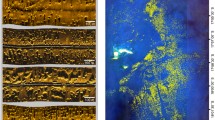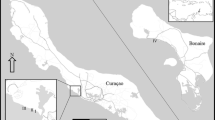Abstract
Studies over time provide opportunities to detect variations in the spatial and temporal patterns of clonal organisms and measure changes on their population dynamics related to extreme events. We assessed population dynamics for a bryozoan species dominating a subtidal rocky reef at Tino Island, in the eastern Ligurian Sea (NW Mediterranean). Using 9 years of annual photosurveys (1997–2005), rapid decline in Pentapora fascialis colony cover was shown at 11 and 22 m depths following the anomalous warming events in 1999 and 2003. An 86 % reduction in live colony portion was found after the 1999 warming event (2.3 °C higher than normal), with larger colonies being most affected. Effects from the 2003 event were delayed, and gradual cover decline occurred during the following 2 years. At the “Shallow” photostations, none of the larger colonies (>1,000 cm2) survived after the first cover decline. Availability of new substrate after the 1999 disturbance resulted in enhanced recovery through new colony production. At the “Deep” photostations, the population structure did not change over the duration of the monitoring period showing the same monomodal structure and same dominant size class (50–500 cm²). In the 4 years following the first cover decline, the deeper population regained colony cover to levels similar to pre-disturbance level, showing a good resilience. This 9-year monitoring analysis provided the temporal resolution needed to detect changes occurring in the P. fascialis population and will contribute to the assessment of long-term changes on benthic populations suffering during recent decades from dramatic increases in extreme events.






Similar content being viewed by others
References
Bader B, Schäfer P (2004) Skeletal morphogenesis and growth check lines in the Antarctic bryozoan Melicerita obliqua. J Nat Hist 38:2901–2922
Barnes DKA (1995) Seasonal and annual growth in erect species of Antarctic bryozoans. J Exp Mar Biol Ecol 188:181–198
Barnes DKA, Webb K, Linse K (2006) Slow growth of Antarctic bryozoans increases over 20 years and is anomalous high in 2003. Mar Ecol Prog Ser 314:187–195
Bellwood D, Hughes T, Folke C, Nyström M (2004) Confronting the coral reef crisis. Nature 429:827–833
Bone EK, Keough MJ (2005) Responses to damage in an arborescent bryozoan: effects of injury location. J Exp Mar Biol Ecol 324:127–140
Bowden DA, Clarke A, Peck LS, Barnes DKA (2006) Antarctic sessile marine benthos: colonization and growth on artificial substrata over 3 yrs. Mar Ecol Prog Ser 316:1–16
Bythell JC, Hillis-Starr ZM, Rogers CS (2000) Local variability but landscape stability in coral reef communities following repeated hurricane impacts. Mar Ecol Prog Ser 204:93–100
Cerrano C, Bavestrello G, Bianchi CN, Cattaneo-Vietti R, Bava S, Morganti C, Morri C, Picco P, Siccardi A, Sponga F (2000) A catastrophic mass-mortality episode of gorgonians and other organisms in the Ligurian Sea (North-western Mediterranean), summer 1999. Ecol Lett 3:284–293
Cerrano C, Arillo A, Calcinai B, Castellano L, Muti C, Valisano L, Zega G, Bavestrello G (2005) Gorgonian population recovery after a mass mortality event. Aquatic Conserv Mar Freshw Ecosyst 15:147–157
Cocito S (2004) Bioconstruction and biodiversity: their mutual influence. Sci Mar 68(1):137–144
Cocito S, Ferdeghini F (2001) Carbonate standing stock and carbonate production of the bryozoan Pentapora fascialis in the north-western Mediterranean. Facies 45:25–30
Cocito S, Sgorbini S, Bianchi CN (1998) Aspects of the biology of the bryozoan Pentapora fascialis in the north-western Mediterranean. Mar Biol 131:73–82
Cocito S, Bedulli D, Sgorbini S (2002) Distribution patterns of the sublittoral epibenthic assemblages on a rocky shoal in the Ligurian Sea (NW Mediterranean). Sci Mar 66(2):175–181
Cocito S, Novosel M, Novosel A (2004) Carbonate bioformations around underwater springs in the north-eastern Adriatic Sea. Facies 50:13–17
Coma R, Linares C, Ribes M, Diaz D, Garrabou J, Ballesteros E (2006) Consequences of a mass mortality in populations of Eunicella singularis (Cnidaria:Octocorallia) in Menorca (NW Mediterranean). Mar Ecol Prog Ser 51:51–60
Connell JH, Keough MJ (1985) Disturbance and patch dynamics of subtidal marine animals on hard substrata. In: Pickett STA, White PS (eds) The ecology of natural disturbance and patch dynamics. Academic Press Inc, London, pp 205–245
Connell JH, Hughes TP, Wallace CC (1997) A 30-year study of coral abundance, recruitment, and disturbance at several scales in space and time. Ecol Monogr 67:461–488
Cupido R, Cocito S, Sgorbini S, Bordone A, Santangelo G (2008) Response of a gorgonian population to mortality events: recovery or loss? Aquatic Conserv Mar Freshw Ecosyst 18:984–992
Cupido R, Cocito S, Barsanti M, Peirano A, Santangelo G (2009) Unexpected long-term population dynamics in a canopy-forming gorgonian following mass mortality. Mar Ecol Prog Ser 394:195–200
Edmunds PJ (2004) Juvenile coral population dynamics track rising seawater temperature on a Caribbean reef. Mar Ecol Prog Ser 269:111–119
Edmunds PJ, Elahi R (2007) The demographics of a 15-year decline in cover of the Caribbean reef coral Montastrea annularis. Ecol Monogr 77(1):3–18
Garrabou J et al (2009) Mass mortality in NW Mediterranean rocky benthic communities: effects of the 2003 heat wave. Glob Change Biol 15:1090–1103
Giorgi F, Lionello P (2008) Climate change projections for the Mediterranean region. Glob Planet Change 63:90–104
Hageman SJ (2003) Complexity generated by iteration of hierarchical modules in Bryozoa. Integr Comp Biol 43(1):87–98
Hall VR, Hughes TP (1996) Reproductive strategies of modular organisms: comparative studies of reef-building corals. Ecology 77:950–963
Hart SP, Keough MJ (2009) Does size predict demographic fate? Modular demography and constraints on growth determine response to decrease in size. Ecology 90(6):1670–1678
Hayward PJ, Ryland JS (1975) Growth, reproduction and larval dispersal in Alcyonidium hirsutum (Fleming) and some other Bryozoa. Pubbl Staz Zool Napoli 39(1):226–241
Hayward PJ, Ryland JS (1999) Cheilostomatous bryozoa, part 2: Hippothooidea–Celleporoidea. In: Barnes RSK, Crothers JH (eds) Synopses of the British Fauna (New Series). Field Studies Council, Shrewsbury
Hughes RN (2005) Lessons in modularity: the evolutionary ecology of colonial invertebrates. Sci Mar 69(1):169–179
Hughes TP, Jackson JBC (1980) Do corals lie about their age? Some demographic consequences of partial mortality, fission and fusion. Science 209:713–715
Hughes TP, Tanner JE (2000) Recruitment failure, life histories, and long-term decline of Caribbean corals. Ecology 81:2250–2263
Hughes TP et al (2003) Climate change, human impacts, and the resilience of coral reefs. Science 301:929–933
Jackson JBC (1979) Morphological strategies of sessile organisms. In: Rosen B, Larwood G (eds) Biology and systematic of colonial animals. Academic Press, London, pp 499–555
Linacre NA, Keough MJ (2003) Demographic effects of fragmentation history in modular organisms: illustrated using the bryozoan Mucropetraliella ellerii (MacGillivray). Ecol Model 170(1):61–71
Lombardi C, Cocito S, Occhipinti-Ambrogi A, Porter JS (2008) Distribution and morphological variation of colonies of the bryozoan Pentapora fascialis (Bryozoa: Cheilostomata) along the western coast of Italy. J Mar Biol Ass UK 88(4):711–717
Lombardi C, Gambi MC, Vasapollo C, Taylor PT, Cocito S (2011a) Skeletal alterations and polymorphism in a Mediterranean bryozoan at natural CO2 vents. Zoomorphology 130:135–145
Lombardi C, Cocito S, Gambi MC, Cisterna B, Flach F, Taylor PD, Keltie K, Freer A, Cusack M (2011b) Effects of ocean acidification on growth, organic tissue and protein profile of the Mediterranean bryozoan Myriapora truncata. Aquatic Biol 13:251–262
Lombardi C, Taylor PD, Cocito S (2013) Bryozoan constructions in a changing Mediterranean Sea. In: Goffredo S, Dubinsky I (eds) The Mediterranean Sea: its history and present challenges. Springer ISBN 978-94-007-6703-4 (in press)
Maughan BC, Barnes DKA (2000) Seasonality of competition in early development of subtidal encrusting communities. Mar Ecol 21:205–220
McKinney FK, Jackson JBC (1989) Bryozoan life histories. In: McKinney FK, Jackson JBC (eds) Bryozoan evolution. University of Chicago Press, Chicago, pp 97–119
Mustapha BK, Komatsu T, Hattour A, Sammari CH, Zarrouk S (2002) Bionomie des étages infra et circalittoral du golfe de Gabès. Bull Inst Nat Sci Techn Mer Salambò 29:1–16
Novosel M (2005) Bryozoans of the Adriatic Sea. Denisia 16. Landesmuseen Neue Serie 28:231–246
Perez T, Garrabou J, Sartoretto S, Harmelin JG, Francour P, Vacelet J (2000) Mass mortality of marine invertebrates: an unprecedented event in the Northwestern Mediterranean. Compt Rend Acad Sci Sci Vie 323:853–865
Pisano E, Boyer M (1985) Development of an infralittoral bryozoan community in the western Mediterranean Sea. Mar Ecol Prog Ser 27:195–202
Relini G, Zamboni N, Tixi F, Torchia G (1994) Patterns of sessile macrobenthos community development on an artificial reef in the Gulf of Genoa (northwestern Mediterranean). Bull Mar Sci 55:745–771
Rodolfo-Metalpa R, Lombardi C, Cocito S, Hall-Spencer JM, Gambi MC (2010) Effects of ocean acidification and high temperatures on the bryozoan Myriapora truncata at natural CO2 vents. Mar Ecol Evol Persp 31:447–456
Sebens KP (1987) The ecology of indeterminate growth in animals. A Rev Ecol Syst 18:371–407
Smith AM (2007) Age, growth and carbonate production by erect rigid bryozoans in Antarctica. Palaeogeogr Palaeoclimatol Palaeoecol 256(1–2):86–98
Smith LD, Hughes TP (1999) An experimental assessment of survival, re-attachment and fecundity of coral fragments. J Exp Mar Biol Ecol 235:147–164
Smith AM, Stewart B, Key Jr MM, Jamet CM (2001) Growth and carbonate production by Adeonellopsis (Bryozoa: Cheilostomata) in Doubtful Sound, New Zealand. Palaeogeogr Palaeoclimatol Palaeoecol 175:201–210
Stebbing ARD (1971) Growth of Flustra foliacea (Bryozoa). Mar Biol 9:267–273
Tanner JE (2001) The influence of clonality on demography: patterns in expected longevity and survivorship. Ecology 82(7):1971–1981
Taylor PD, Wilson MA (2003) Palaeoecology and evolution of marine hard substrate communities. Earth-Science Rev 62:1–103
Teixidó N, Pineda MC, Garrabou J (2009) Decadal demographic trends of a long-lived temperate encrusting sponge. Mar Ecol Prog Ser 375:113–124
Teixidó N, Casas E, Cebrian E, Linares C, Garrabou J (2013) Impacts on coralligenous outcrop biodiversity of a dramatic coastal storm. PLoS ONE 8(1):e53742
Todd CD, Turner SJ (1986) Ecology of intertidal and sublittoral cryptic epifaunal assemblages. I. Experimental rationale and the analysis of larval settlement. J Exp Mar Biol Ecol 99:199–231
Watson DI, Barnes DKA (2004) Temporal and spatial components of variability in benthic recruitment, a 5-year temperate example. Mar Biol 145:201–214
Wilson SK, Graham NAJ, Pratchett MS, Jones GP, Polunin NVC (2006) Multiple disturbances and the global degradation of coral reefs: are reef fishes at risk or resilient? Glob Change Biol 12:2220–2234
Wood ACL, Probert PK, Rowden AA, Smith AM (2012) Complex habitat generated by marine bryozoans: a review of its distribution, structure, diversity, threats and conservation. Aquatic Conserv Mar Fresh Ecosys 22:547–563
Woodley JD et al (1981) Hurricane Allen’s impact on Jamaican coral reefs. Science 214:749–755
Acknowledgments
Authors dedicated this paper to late M. Lorenzetti (Submariner, La Spezia) and late M. Morgigni (Lucca) that provided valuable field assistance. Authors are grateful to two anonymous reviewers for their constructive comments on this paper. We thank N.M. Lucey (Cambridge, Massachusetts) for her revision of the English text.
Author information
Authors and Affiliations
Corresponding author
Additional information
Communicated by S. Connell.
Rights and permissions
About this article
Cite this article
Cocito, S., Sgorbini, S. Long-term trend in substratum occupation by a clonal, carbonate bryozoan in a temperate rocky reef in times of thermal anomalies. Mar Biol 161, 17–27 (2014). https://doi.org/10.1007/s00227-013-2310-9
Received:
Accepted:
Published:
Issue Date:
DOI: https://doi.org/10.1007/s00227-013-2310-9




